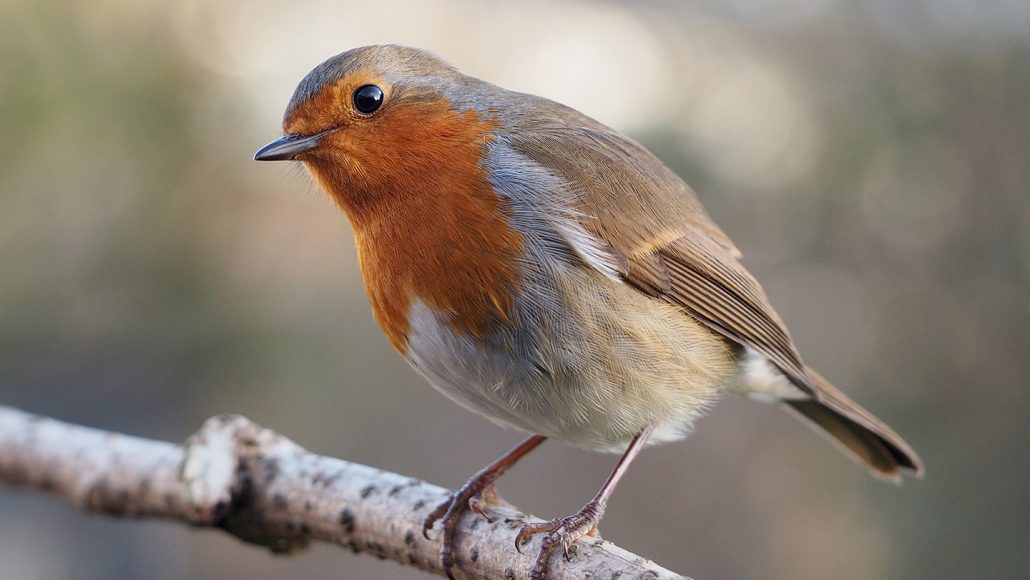Birds could get their sense of direction from quantum physics
European robins have a protein in their eye that is sensitive to magnetic fields

This European robin is a species that makes annual migrations. Flocks of them are guided along the way by their innate sense of north and south. A protein in the birds’ eyes could be behind their navigation prowess.
© Francis C. Franklin / CC-BY-SA-3.0
European robins don’t need a compass. That’s because they can sense magnetic fields that help them tell north from south. Some scientists had thought this superpower might be based on quantum physics. That’s the science of very small stuff, such as atoms and electrons. New research makes that idea of a quantum “compass” now seem even more likely.
Songbirds like European robins need to sense Earth’s magnetic field to navigate as they make yearly long-distance treks. A special protein in the birds’ eyes could be behind this. That protein is called CRY4. It’s short for cryptochrome (KRIP-toh-kroam) 4.
Some scientists think CRY4 acts like a tiny compass needle. And quantum physics could explain how it works. If true, it would be a step forward for biophysicists. These scientists study how physics and biology work together. They seek to understand when quantum physics can become important for living creatures.
Until now, no one had ever measured whether CRY4 would actually respond to magnetic fields. So scientists studied this protein in the lab They looked at a type of CRY4 found in the eyes of European robins (Erithacus rubecula). The researchers found it indeed responds to magnetic fields. That’s needed for it to serve as a compass.
The researchers reported their results June 24 in Nature.
“This is the first paper that actually shows that birds’ cryptochrome 4 is magnetically sensitive,” says Rachel Muheim. A sensory biologist, she works at Lund University in Sweden.
Truly weird
Scientists think CRY4 needs blue light to work. When light of those wavelengths hits the protein, it sets off a series of reactions. Those reactions shuttle an electron around. In the end, there are two unpaired electrons in different parts of the protein. Those lone electrons behave like tiny magnets. That’s thanks to a quantum property of electrons known as spin.
The two electrons’ magnets can point parallel to one another or in opposite directions. But the electrons do not settle on either arrangement. They exist in a weird quantum limbo. It’s called a quantum superposition. It describes only the probability of finding the electrons in either arrangement.
At the end of the reaction, the protein can morph into a different version — or go back to the way it started. Which one it chooses depends on those electron probabilities.
And here’s where magnetic fields come in. A magnetic field changes the likelihood of the electrons pointing in the same direction. That changes the amount of the new form of protein formed. Birds may sense that change. In that way, they may detect Earth’s magnetic field.
But no one yet understands that part of the process. “How does the bird perceive this? We don’t know,” admits Peter Hore. He’s a chemist at the University of Oxford. He’s also an coauthor of the new study.
The idea that cryptochromes play some role in bird compasses has been around for decades. But “no one could confirm this” in tests, notes Jingjing Xu. She is a biochemist. She works at the University of Oldenburg in Germany. So in a new study, she, Hore and their colleagues hit the CRY4 protein with light from a blue laser. Then they observed what happened.
The protein absorbed some of the light. When the researchers turned on a magnetic field, that changed how much light the protein absorbed. That’s one sign that the magnetic field changed how much of the altered form of the protein had been made.
The researchers didn’t look at proteins inside birds’ eyes. Instead, they did their tests on proteins in a liquid inside a tube. That makes the new findings harder to interpret. The protein might respond differently in the liquid than in a bird’s eye. For example, scientists think the proteins in eyes may be lined up in one direction. In the future, the researchers hope to perform studies on actual eyes. And that would give them a literal bird’s-eye view.







